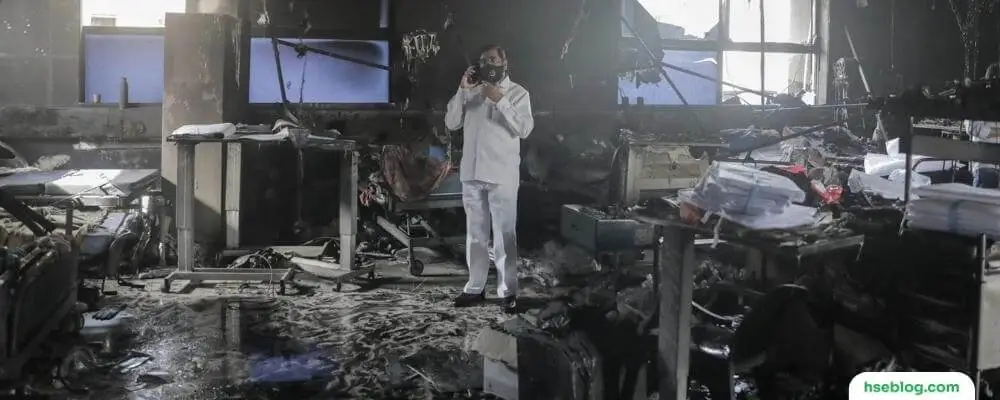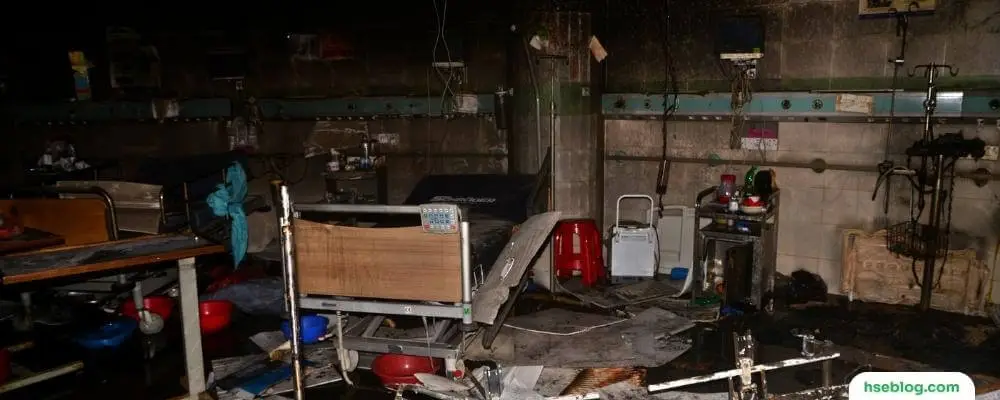Hospitals are one of the most common places for fires to occur. In fact, according to the National Fire Protection Association, hospital fires account for about 9% of all reported fires each year. These fires can cause serious damage and even loss of life. In this blog post, we will discuss the different causes of hospital fires and some control measures that can be taken to prevent them from happening.
Fires in hospitals are not a new phenomenon. In fact, they’ve been around since the early days of healthcare. The first recorded hospital fire was 1773 at the Pennsylvania Hospital in Philadelphia. Since then, many other fires have resulted in loss of life and property damage. Several factors contribute to the risk of fires in hospitals. These include aging infrastructure, inadequate fire safety regulations, and human error.
Aging infrastructure is one of the most significant contributors to the risk of fires in hospitals. Many hospital buildings are old and outdated, which means they often don’t have up-to-date fire safety features. This can make it more difficult to evacuate patients in a fire and make it more likely that a fire will spread.
Causes of Hospital Fires and Control Measures
The potential for fire in a hospital setting can occur from many different sources, such as heat-producing equipment, storage of flammable chemicals, and faulty electrical wiring.
1. Electrical Equipment
The most common cause of hospital fires is electrical equipment. To prevent these fires, hospitals should follow some basic safety guidelines. All electrical equipment should be properly maintained and checked regularly. Overworked sockets and cables often cause fires, so power strips must be plugged directly into an outlet, not daisy-chained (linking power strips together). Hospitals should also install automatic shut-off devices on all electrical equipment if possible. Hospitals can help prevent fires and keep their patients safe by following simple safety guidelines.
2. Kitchen Facilities
One such fire occurred at a hospital in California, causing $11 million in damage and shutting down the facility for over two months. The fire was traced back to an electrical toaster in the kitchen. While no one was injured, the damage caused by the fire was extensive.
This is just one example of how a kitchen fire can cause significant damage. To prevent fires in your kitchen, keep an eye on electrical appliances and never leave them unattended. If you use cooking fats, properly dispose of them so they don’t build up and cause a fire. And as always, practice good fire safety by having a working smoke detector in your kitchen. By following these simple tips, you can help prevent a kitchen fire in your own home.
Did you know that fires in kitchen facilities are actually quite common? In fact, they’re one of the leading causes of fires in commercial buildings. This is because cooking fats, electrical appliances, and open flames are potential ignition sources.

3. Cigarettes
Cigarettes are one cause of hospital fires, according to the National Fire Protection Association (NFPA). In fact, cigarettes are responsible for more than $400 million in damage each year.
While cigarettes are banned in healthcare facilities, people might sneak them indoors or, while smoking outdoors, don’t properly dispose of them.
Cigarette fires in hospitals can be especially dangerous because patients are often sick and cannot evacuate quickly. In addition, hospital fires can spread rapidly due to the many flammable materials in these buildings.
To prevent hospital fires, the NFPA recommends:
- Properly disposing of cigarettes
- Not smoking indoors
- Creating a “no smoking” policy for the entire facility
Following these simple guidelines can help keep our hospitals safe from fire.
4. Specialized Medical Equipment
In recent years, there have been an increasing number of hospital fires caused by specialized medical equipment. Due to their high-powered energy output, lasers and electrosurgical tools are common ignition sources. These fires involve oxygen tanks, surgical clothing, and flammable sterilizing liquids.
Hospital staff must be aware of the potential fire hazards these types of equipment pose and take precautions to prevent them. Lasers and electrosurgical tools should be used in well-ventilated areas, and avoided from oxygen tanks, surgical clothing, and flammable liquids. If possible, these items should be stored in fire-resistant cabinets or containers.
In a fire, hospital staff should follow established fire safety procedures. Evacuate the area immediately and call the fire department. Do not try to extinguish the fire yourself, as this could put you at risk of injury. By taking these simple precautions, hospital staff can help prevent fires caused by specialized medical equipment.
5. Hand Sanitizers
Alcohol-based hand rubs are commonly used in hospitals to prevent the spread of infection. However, these products can be highly flammable and must be kept at least six feet away from potential ignition sources. In recent years, several hospital fires have been caused by improper storage or use of hand sanitizer, resulting in significant damage and even loss of life.
To prevent such tragedies, all staff must be properly trained in safely storing and using hand sanitizers. Additionally, hospitals should consider investing in non-flammable alternatives to alcohol-based products, which can provide the same level of protection without the same fire risk. With proper precautions in place, we can help to ensure that hospital fires are a thing of the past.

6. Gas Cylinders and Medical Oxygen Compliance
According to the National Fire Protection Association, hospital fires are caused by gas cylinders and medical oxygen more often than other factors. In fact, over a five-year period, gas cylinders and medical oxygen were responsible for nearly 25% of all hospital fires.
While the causes of these fires vary, improper storage and securing of gas cylinders and medical oxygen are often to blame. It is important to ensure that all gas cylinders and medical oxygen are properly stored and secured to prevent these fires.
Some tips for proper storage and securing of gas cylinders and medical oxygen include:
- Store gas cylinders and medical oxygen in a well-ventilated area
- Secure gas cylinders and medical oxygen so that they cannot be knocked over
- Inspect gas cylinders and medical oxygen regularly for leaks
These simple tips can help prevent hospital fires caused by gas cylinders and medical oxygen.
7. Anesthesia Machines
Anesthesia machines are critical tools in hospitals, but they can also pose a significant fire risk due to the high oxygen concentration they produce. Oxygen accelerates combustion, and any spark or heat source nearby can cause a fire. To mitigate this risk, performing regular maintenance on these machines and training staff to use them properly is crucial. Moreover, any flammable materials should be kept far away from anesthesia machines.
8. Extension Cord Daisy Chains
Extension cords are common in many hospitals, often used to chain together various pieces of equipment. However, using extension cords in this way is actually a violation of hospital safety standards. Extension cords can become overheated, posing a fire risk. In addition, they can create trip hazards and may not provide enough power for some types of equipment. Hospitals should avoid using extension cords and instead use dedicated power lines for each piece of equipment if possible.
9. Inadequate Fire Training
The lack of adequate fire safety training and awareness among hospital staff can lead to fire outbreaks. In many cases, fires may start small but turn catastrophic because individuals don’t know how to react or use fire-fighting equipment. Regular fire safety training and drills for all staff, including night-shift workers, should be mandatory in hospitals. The training should cover how to respond in case of a fire, use fire extinguishers, and safely evacuate patients.
10. Storage of Combustible Materials
Improper storage of combustible materials like paper, cloth, and plastics can also lead to hospital fires. These materials should be kept in designated, secure, and fire-resistant storage areas, away from heat or ignition sources. Furthermore, waste disposal policies should be in place to ensure that these materials do not accumulate and pose a fire risk.

11. Faulty or Poorly Maintained Fire Safety Systems
A faulty fire alarm or a poorly maintained sprinkler system can significantly increase the risk of a fire spreading in a hospital. Regular maintenance and testing of fire safety systems, including alarms, extinguishers, and sprinkler systems, are crucial. If these systems are not working properly, a minor fire can quickly get out of control.
12. Heating Equipment
Heating equipment like portable heaters, boilers, and furnaces are common sources of hospital fires, especially during colder months. These devices should be kept safe from flammable materials and regularly inspected and maintained to ensure they function correctly.
Control measures include training staff to recognize potential fire hazards associated with heating equipment and having protocols in place for regular inspection and maintenance. Automatic shut-off features can also be helpful in case a device overheats or tips over.
By understanding the many potential causes of hospital fires and implementing comprehensive fire prevention and control measures, hospitals can significantly reduce the fire risk and ensure the safety of their patients and staff.
Hospital Fire Safety Tips
- Conduct regular fire safety training and drills for all staff, including night-shift workers.
- Ensure that all fire safety equipment, including fire extinguishers, smoke detectors, and sprinkler systems, are properly installed, regularly inspected, and maintained.
- Develop and communicate a clear evacuation plan for patients, staff, and visitors in case of a fire. Practice the evacuation plan through drills to ensure everyone knows their roles and escape routes.
- To facilitate easy evacuation and access for emergency responders, keep all hospital areas clear of clutter, especially in hallways, stairwells, and emergency exits.
- Store and handle flammable materials, chemicals, and gases in designated areas that meet safety standards and regulations.
- Follow proper electrical safety protocols, including regular equipment maintenance, avoiding overloading sockets, and safely managing electrical cords and outlets.
- Enforce a strict no-smoking policy throughout the hospital premises, and provide designated smoking areas away from buildings.
- Properly store and handle oxygen cylinders, ensuring they are secured and stored away from potential ignition sources.
- Educate staff about potential fire hazards associated with specialized medical equipment and train them on safe operating procedures.
- Install fire-resistant doors and barriers to compartmentalize areas and prevent fire spread.
- Regularly inspect and maintain heating and cooling systems, boilers, and other heat-producing equipment to prevent malfunctions and potential fire hazards.
- Have emergency communication systems in place to quickly alert staff, patients, and visitors in case of a fire.
Fire safety is a collective responsibility, and everyone in the hospital should be actively involved in preventing and responding to fires.
Conclusion
Hospital fires can have devastating consequences, particularly due to the vulnerability of patients and the essential nature of the services provided. Causes of these fires vary widely, from electrical and kitchen equipment to smoking, specialized medical equipment, hand sanitizers, gas cylinders, medical oxygen, and even the misuse of extension cords.
Recognizing these causes, educating staff, maintaining equipment, and implementing strict safety protocols are all pivotal to reducing the risk. By proactively managing potential risks and adhering to robust fire safety measures, hospitals can prevent fires and ensure a swift and safe response should a fire occur, thereby protecting both lives and property.

